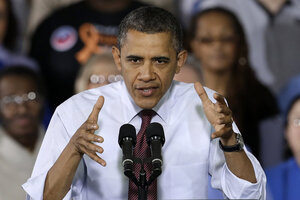White House opts not to create a Death Star. But a ‘magic coin’?
A number of fanciful ideas on economic policy have been floated in recent weeks. The so-called Death Star idea, officially rejected, was a stimulus plan. The 'magic coin' plot is meant to sidestep a showdown with Congress over the national debt ceiling. Seriously?

President Obama speaks to workers about the economy during a visit to Daimler Detroit Diesel in Redford, Mich., last month. The scene playing out on Capitol Hill is a familiar one as lawmakers with competing ideologies begin to wage another battle over raising the national debt ceiling.
Paul Sancya/AP
This much is now official: The Obama administration won’t get behind the idea of building a Death Star “space-superiority platform” to create jobs and strengthen national defense. That idea sprang up as an online petition to the White House two months ago, gathering sizable support, presumably coming in good measure from fans of a certain movie series.
The president’s policy troopers came back with a response that included playful humor ("This Isn't the Petition Response You're Looking For") but also budgetary realism. (A Death Star would be costly, and “we're working hard to reduce the deficit, not expand it.”)
But building a “Star Wars” platform for space-based weaponry isn’t the only fanciful economic policy idea that’s been floated in recent weeks. Another one that’s garnered attention in recent days has to do with another round object, a simple coin. Specifically, the notion is that the US Treasury could avert the next partisan stalemate on fiscal policy by issuing a $1 trillion platinum coin, and depositing it at the Federal Reserve.
It’d be a stealth way to sidestep confrontation over whether Congress should raise the official debt limit, so that the Treasury could borrow money to pay the nation’s bills. Many Republicans would like to use the debt-ceiling issue as leverage in pushing for reductions in federal spending.
This “magic coin” idea, like the Death Star one, has thousands of supporters behind it as an online petition on the White House’s “We the People” petition venue.
“We would avert the absurd-yet-imminent debt ceiling faceoff in Congress in two quick and simple steps!” the petition states. “While this may seem like an unnecessarily extreme measure, it is no more absurd than playing political football with the US – and global – economy at stake.”
The $1 trillion coin could in theory give the Treasury fiscal breathing room. Rather than wait for Congress to approve more borrowing – and see the nation effectively default on its debt if Congress fails to do so quickly – the administration would employ the coin as a kind of bank account with the Federal Reserve against which the Treasury could draw.
Would it be legal and practical?
Well, technically, the law authorizes the Treasury secretary to issue commemorative platinum coins “in such quantity and of such variety as the secretary determines to be appropriate.”
Backers of the idea say the coin need not be large in size. It needn’t contain an amount of platinum that would actually be worth $1 trillion.
That doesn’t mean the idea would work, though. Many economists have publicly rejected the idea.
Economists Ethan Harris and Michael Hanson at Bank of America Merrill Lynch sum up their views this way: “We see several problems with this plan. First, its legality is open to question. Second, it would worsen the coming battle over spending cuts. Moreover, it would further deepen the distrust between the two political parties. Finally, it risks being the first step down a slippery slope of debt monetization.”
Debt “monetization” is a fancy term for what happens when a central bank, such as the Fed, allows inflation to eat away at a currency’s value, as a way of making it easier for a government to pay off its debts.
Paul Krugman, an economist and New York Times columnist, notes that behind all the discussion of a $1 trillion coin a deeper question is implied: Can federal deficits be solved in part by having the Treasury simply print more money, rather than by borrowing?
The answer is no. Other than the provision in law for an occasional platinum coin, America’s money creation is managed by the Federal Reserve, which puts money into circulation by buying federal debt, Mr. Krugman explains.
Moreover, even if the Treasury tried the trillion-dollar trick, “the coin really would be as much a Federal debt as the T-bills the Fed owns, since eventually Treasury would want to buy it back,” Krugman wrote on Jan. 2.
So it's pretty safe to count on the coin gambit not happening.
But these petitions, whether they’re about a Death Star or a giant-denomination coin, do have a virtue of starting some educational discussions!

